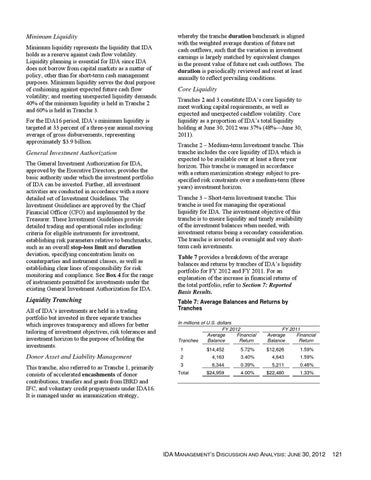Minimum Liquidity Minimum liquidity represents the liquidity that IDA holds as a reserve against cash flow volatility. Liquidity planning is essential for IDA since IDA does not borrow from capital markets as a matter of policy, other than for short-term cash management purposes. Minimum liquidity serves the dual purpose of cushioning against expected future cash flow volatility; and meeting unexpected liquidity demands. 40% of the minimum liquidity is held in Tranche 2 and 60% is held in Tranche 3. For the IDA16 period, IDA’s minimum liquidity is targeted at 33 percent of a three-year annual moving average of gross disbursements, representing approximately $3.9 billion.
General Investment Authorization The General Investment Authorization for IDA, approved by the Executive Directors, provides the basic authority under which the investment portfolio of IDA can be invested. Further, all investment activities are conducted in accordance with a more detailed set of Investment Guidelines. The Investment Guidelines are approved by the Chief Financial Officer (CFO) and implemented by the Treasurer. These Investment Guidelines provide detailed trading and operational rules including: criteria for eligible instruments for investment, establishing risk parameters relative to benchmarks, such as an overall stop-loss limit and duration deviation, specifying concentration limits on counterparties and instrument classes, as well as establishing clear lines of responsibility for risk monitoring and compliance. See Box 4 for the range of instruments permitted for investments under the existing General Investment Authorization for IDA.
Liquidity Tranching All of IDA’s investments are held in a trading portfolio but invested in three separate tranches which improves transparency and allows for better tailoring of investment objectives, risk tolerances and investment horizon to the purpose of holding the investments.
whereby the tranche duration benchmark is aligned with the weighted average duration of future net cash outflows, such that the variation in investment earnings is largely matched by equivalent changes in the present value of future net cash outflows. The duration is periodically reviewed and reset at least annually to reflect prevailing conditions.
Core Liquidity Tranches 2 and 3 constitute IDA’s core liquidity to meet working capital requirements, as well as expected and unexpected cashflow volatility. Core liquidity as a proportion of IDA’s total liquidity holding at June 30, 2012 was 37% (48%—June 30, 2011). Tranche 2 – Medium-term Investment tranche. This tranche includes the core liquidity of IDA which is expected to be available over at least a three year horizon. This tranche is managed in accordance with a return maximization strategy subject to prespecified risk constraints over a medium-term (three years) investment horizon. Tranche 3 – Short-term Investment tranche. This tranche is used for managing the operational liquidity for IDA. The investment objective of this tranche is to ensure liquidity and timely availability of the investment balances when needed, with investment returns being a secondary consideration. The tranche is invested in overnight and very shortterm cash investments. Table 7 provides a breakdown of the average balances and returns by tranches of IDA’s liquidity portfolio for FY 2012 and FY 2011. For an explanation of the increase in financial returns of the total portfolio, refer to Section 7: Reported Basis Results. Table 7: Average Balances and Returns by Tranches In millions of U.S. dollars FY 2012 Average Financial Tranches Balance Return
FY 2011 Average Financial Balance Return
1
$14,452
5.72%
$12,626
1.59%
Donor Asset and Liability Management
2
4,163
3.40%
4,643
1.59%
This tranche, also referred to as Tranche 1, primarily consists of accelerated encashments of donor contributions, transfers and grants from IBRD and IFC, and voluntary credit prepayments under IDA16. It is managed under an immunization strategy,
3
6,344
0.39%
5,211
0.46%
$24,959
4.00%
$22,480
1.33%
Total
IDA MANAGEMENT’S DISCUSSION AND ANALYSIS: JUNE 30, 2012
121
